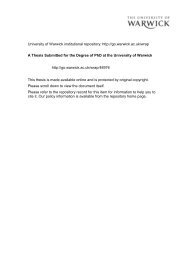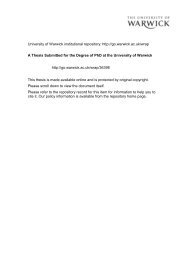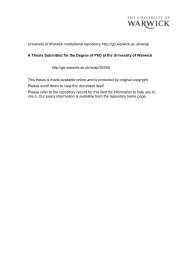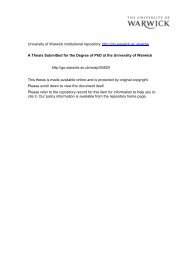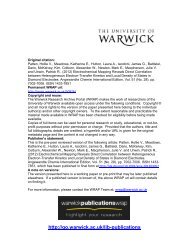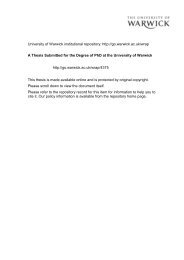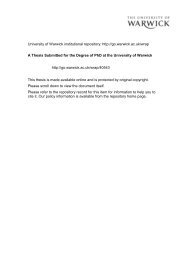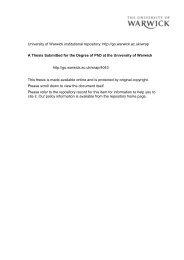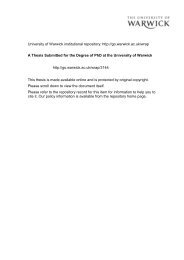Download (13Mb) - WRAP: Warwick Research Archive Portal ...
Download (13Mb) - WRAP: Warwick Research Archive Portal ...
Download (13Mb) - WRAP: Warwick Research Archive Portal ...
Create successful ePaper yourself
Turn your PDF publications into a flip-book with our unique Google optimized e-Paper software.
inward-looking nature of these spaces is often exacerbated by an absence of windows<br />
and a profusion of mirrors, which dramatize the introspective nature of her fantasy<br />
worlds. The closed space has long been recognised as the privileged space of the<br />
fantastic. According to Rosemary Jackson the fantastic creates 'an additional space'<br />
and 'this space is frequently narrowed down into a place or enclosure, where the<br />
fantastic has become the norm. Enclosure is central to modem fantasy' .41 This pattern<br />
seems to coincide with a large number offemale-authored fantastic texts. With further<br />
depictions ofthe enclosed space as a prison, labyrinth, grave, cave, it has traditionally<br />
been the locus of the female character and rarely a positive one. As such it also<br />
coincides with women's hitherto limited space within literature. The otherness of the<br />
fantastic space suggests that art offers some form of liberation only to present another<br />
set of walls. One of the principal reasons for this is the necessity of using a (literary)<br />
language that always articulates woman as Other. In this analysis ofCapriolo's work I<br />
will explore how this anxiety manifests itself as link between spatial enclosure and the<br />
limitations imposed by literary tradition, and more generally the dominant cultural<br />
text which governs women's lives. Literary tradition may form just one part of that<br />
cultural text but its primary connection to fiction gives it a privileged position in the<br />
symbolic expression ofthat dominance.<br />
The most obvious way in which women are situated differently in relation to<br />
enclosure is through a perception of the female body as imprisoning mechanism. This<br />
perception has been reinforced historically by establishing female worth around the<br />
potential to function as a reproductive tool. Subsequently the enclosure of the body<br />
has been one of the few acceptable ways in which women have been able to access<br />
the sphere of creativity, always on many conditions. Female interiority, which women<br />
writers are at pains to reappropriate in order to gain access to a creative space, is<br />
dogged by its associations with the reproductive space. 42<br />
The protagonist of 'La<br />
Studies, 18 (2000),157-171 (p.159).<br />
41 Jackson,pp.46-7.<br />
42 In Sexual Politics (London: Virago, 1981, first publ. 1969, pp.210-219) Kate Millet cites Erik<br />
Erikson's notoriously essentialist study of male/female attitudes towards space, in which he equates<br />
anatomy with destiny. See Erik Erikson, 'Womanhood and the Inner Space' (1964) in Identity, Youth<br />
and Crisis (New York: Norton, 1968). Adriana Cavarero suggests that the recent focus in Italian<br />
feminism upon the matemal has provided some attempts to reappropriate the space of female creativity<br />
by expanding our understanding of the matemal. She cites Silvia Vegetti Finzi, who suggests that the<br />
infant desire of the girl child to produce autonomously is channelled by social codes into a desire to<br />
produce a child: 'La sua proposta e cosi la ridefinizione di un campo simbolico che permetta alIa<br />
pulsione generativa femminile di realizzare la propria creativa che ha, da un lato, il vantaggio di unire<br />
in un solo nodo il corpo e il pensiero, e ha d'altro lato, la possibilita di trascendere la generazione<br />
13




